7
After you enable automatic link aggregation and LLDP on two connected devices, they automatically
establish a dynamic link aggregation based on the information in incoming LLDP frames. The
devices each automatically create a dynamic aggregate interface and assign the redundant ports
connected to the peer to the aggregation group of that interface. When assigning the first member
port to the aggregate group, the device synchronizes the member port's attribute configuration to the
aggregate interface.
An automatically created dynamic aggregation group selects a reference port and Selected ports as
described in "How dynamic link aggregation works." T
he aggregation group creation methods do not
change the processes of reference port selection and Selected port selection.
IMPORTANT:
s a best practice to ensure correct operation of dynamic aggregation groups, do not use automatic
link aggregation and automatic member port assignment together.
How dynamic link aggregation works
Choosing a reference port
The system chooses a reference port from the member ports in up state. A Selected port must have
the same operational key and attribute configurations as the reference port.
The local system (the actor) and the peer system (the partner) negotiate a reference port by using
the following workflow:
1. The two systems determine the system with the smaller system ID.
A system ID contains the LACP system priority and the system MAC address.
a. The two systems compare their LACP priority values.
The lower the LACP priority, the smaller the system ID. If the LACP priority values are the
same, the two systems proceed to step b.
b. The two systems compare their MAC addresses.
The lower the MAC address, the smaller the system ID.
2. The system with the smaller system ID chooses the port with the smallest port ID as the
reference port.
A port ID contains a port priority and a port number. The lower the port priority, the smaller the
port ID.
a. The system chooses the port with the lowest priority value as the reference port.
If the ports have the same priority, the system proceeds to step b.
b. The system compares their port numbers.
The smaller the port number, the smaller the port ID.
The port with the smallest port number and the same attribute configurations as the
aggregate interface is chosen as the reference port.
NOTE:
To identify the port numbers of aggregation member ports, execute the
display
link-aggregation verbose
command and examine the Index field in the command
output.
Setting the aggregation state of each member port
After the reference port is chosen, the system with the smaller system ID sets the state of each
member port on its side.

